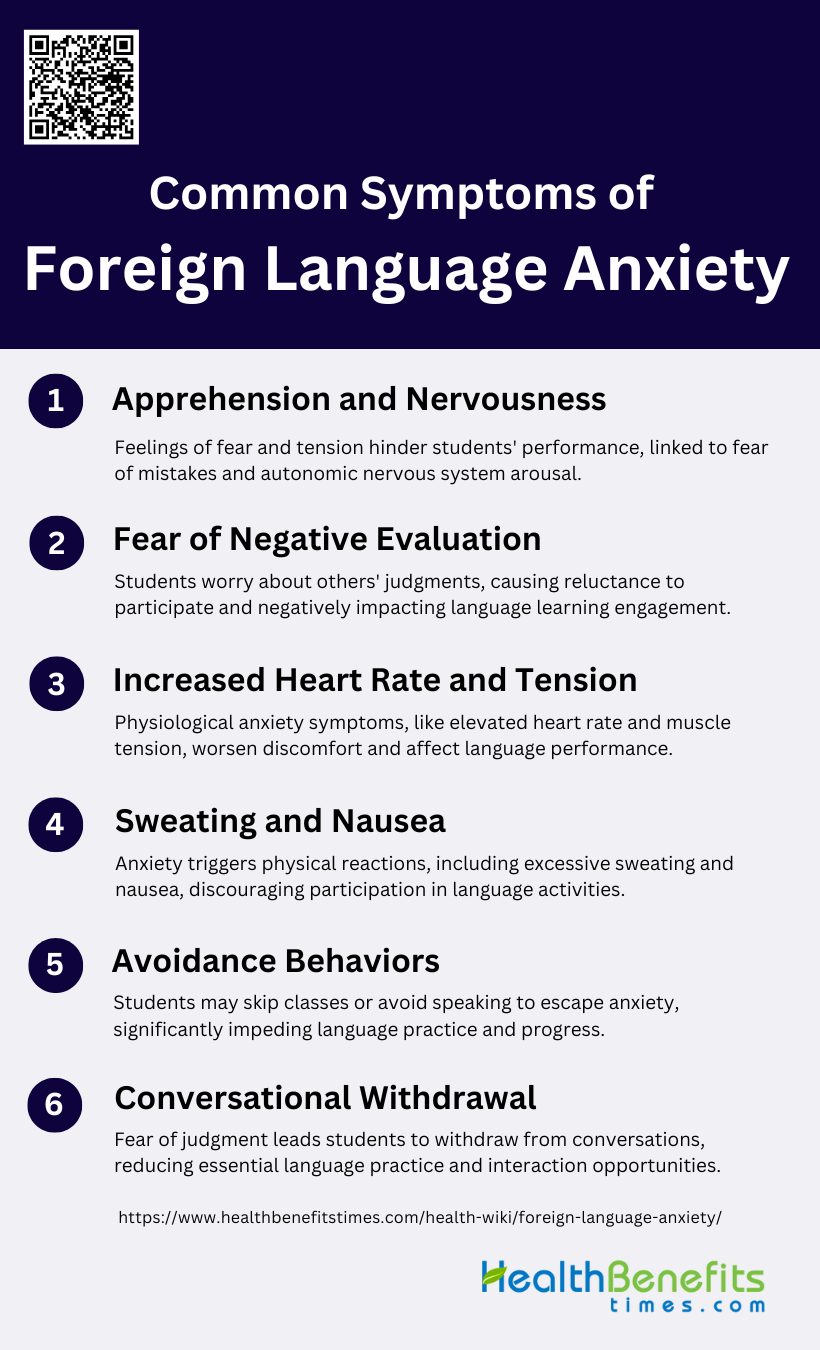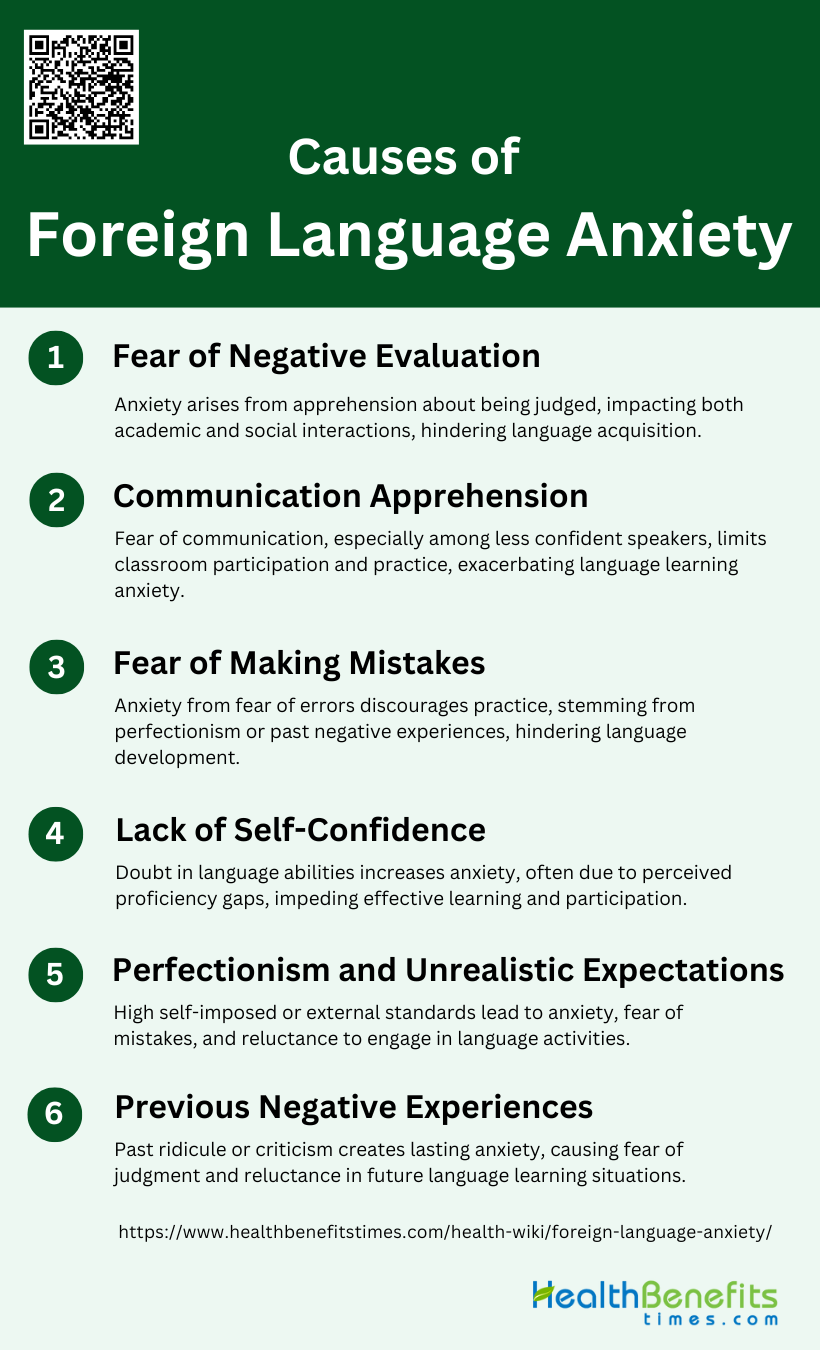Foreign Language Anxiety (FLA) is a specific type of anxiety experienced by individuals when learning or using a foreign language. It is characterized by a complex interplay of self-perceptions, beliefs, attitudes, and behaviors related to the language learning process. The anxiety often stems from concerns over assessments, communication apprehension, and the fear of negative evaluation, which can lead to academic, cognitive, and social challenges. FLA can manifest in various forms, such as speaking, listening, and overall language performance anxiety, and is considered one of the most significant barriers to effective language acquisition. This anxiety can cause physical symptoms, resistance to using the language, and a decrease in self-confidence, ultimately hindering language learning success.
Common Symptoms of Foreign Language Anxiety
Foreign language anxiety is a prevalent issue among language learners, manifesting through various psychological and physical symptoms. These symptoms can significantly hinder the learning process and affect the learner’s confidence and performance. Below are some of the most common symptoms associated with foreign language anxiety:
1. Apprehension and Nervousness
Apprehension and nervousness are common symptoms of foreign language anxiety (FLA). These feelings often stem from the fear of making mistakes or being judged by peers and instructors. In classroom settings, students may experience heightened levels of tension and worry, which can impede their ability to perform well in language tasks. This anxiety is not limited to language learning but can also be observed in other academic areas such as science and mathematics. The subjective feeling of apprehension and nervousness is closely associated with the arousal of the autonomic nervous system, making it a significant barrier to successful language acquisition.
2. Fear of Negative Evaluation
Fear of negative evaluation is another prevalent symptom of FLA. This fear involves concerns about others’ judgments and the potential for negative feedback, which can be particularly daunting in a classroom environment. Students often worry about their peers’ and teachers’ perceptions of their language abilities, leading to increased anxiety levels. This fear can be so overwhelming that it hinders students’ willingness to participate in class activities, thereby affecting their overall language learning experience. Studies have shown that fear of negative evaluation is a significant source of FLA, contributing to students’ reluctance to engage in speaking and listening tasks.
3. Increased Heart Rate and Tension
Increased heart rate and muscle tension are physiological symptoms commonly associated with FLA. These physical manifestations of anxiety can occur when students are required to speak or perform in a foreign language, triggering the body’s fight-or-flight response. The autonomic nervous system’s activation leads to an elevated heart rate and muscle tension, which can further exacerbate feelings of anxiety and discomfort. These symptoms not only affect students’ performance but also their overall well-being, making it crucial to address and manage FLA effectively.
4. Sweating and Nausea
Sweating and nausea are additional physical symptoms that students may experience due to FLA. These symptoms are often triggered by the stress and anxiety associated with speaking or performing in a foreign language. The body’s response to anxiety can include excessive sweating and feelings of nausea, which can be particularly distressing for students. These physical reactions can further contribute to students’ reluctance to participate in language activities, thereby hindering their language learning progress. Addressing these symptoms is essential for creating a supportive and effective language learning environment.
5. Avoidance Behaviors
Avoidance behaviors are a common coping mechanism for students experiencing FLA. These behaviors can include skipping classes, avoiding speaking in front of others, and steering clear of language-related activities. Such avoidance can significantly impede language learning, as it prevents students from engaging in essential practice and interaction. The fear of making mistakes or being judged often drives these behaviors, leading to a cycle of increased anxiety and decreased language proficiency. Identifying and addressing avoidance behaviors is crucial for helping students overcome FLA and achieve their language learning goals.
6. Conversational Withdrawal
Conversational withdrawal is another symptom of FLA, where students may withdraw from participating in conversations or classroom discussions. This withdrawal can be due to the fear of negative evaluation, apprehension, and the physical symptoms of anxiety. Students may choose to remain silent or provide minimal responses to avoid the stress associated with speaking in a foreign language. This behavior can limit their opportunities for practice and interaction, which are vital for language acquisition. Encouraging a supportive and non-judgmental classroom environment can help reduce conversational withdrawal and promote active participation.
Causes of Foreign Language Anxiety
Foreign language anxiety can arise from multiple sources, impacting learners’ ability to effectively acquire a new language. Understanding these causes is crucial for developing strategies to mitigate anxiety and improve language learning outcomes. Below are some common causes of foreign language anxiety:
1. Fear of Negative Evaluation
Fear of negative evaluation is a significant cause of foreign language anxiety (FLA). This fear stems from the apprehension of being judged unfavorably by others, which can be particularly intense in language learning contexts. Studies have shown that students often worry about receiving low grades or being corrected, which exacerbates their anxiety levels. This fear is not limited to academic settings; it can also affect professional and social interactions where language proficiency is required. The anxiety associated with fear of negative evaluation can hinder language acquisition and reduce learners’ confidence, making it a critical factor to address in educational practices.
2. Communication Apprehension
Communication apprehension is another primary source of FLA, characterized by the fear or anxiety associated with real or anticipated communication with others. This type of anxiety is particularly prevalent among students who lack confidence in their speaking abilities. The apprehension can be so severe that it prevents learners from participating in classroom activities, thereby limiting their opportunities to practice and improve their language skills. Communication apprehension is often linked to a lack of self-confidence and can be exacerbated by previous negative experiences in language learning. Addressing this form of anxiety is crucial for creating a supportive learning environment that encourages active participation and communication.
3. Fear of Making Mistakes
The fear of making mistakes is a common cause of FLA, particularly among learners who strive for perfection. This fear can be debilitating, as it discourages students from speaking or writing in the foreign language due to the anxiety of making errors. The pressure to avoid mistakes can lead to a lack of practice, which in turn hampers language development. This fear is often rooted in previous negative experiences where mistakes were met with criticism or ridicule, further reinforcing the anxiety. Educators need to create a supportive environment that encourages risk-taking and views mistakes as a natural part of the learning process.
4. Lack of Self-Confidence
Lack of self-confidence is a significant contributor to FLA. Students who doubt their language abilities are more likely to experience anxiety, which can impede their learning process. This lack of confidence often stems from a perceived gap between their current proficiency and the expected level of performance. It can also be influenced by previous negative experiences and the fear of negative evaluation. Building self-confidence in language learners is essential for reducing anxiety and promoting a more positive and effective learning experience. Strategies such as positive reinforcement and incremental goal-setting can help boost learners’ confidence.
5. Perfectionism and Unrealistic Expectations
Perfectionism and unrealistic expectations can significantly contribute to FLA. Learners who set excessively high standards for themselves are more prone to anxiety when they fail to meet these expectations. This perfectionist attitude can lead to a fear of making mistakes and a reluctance to participate in language activities, thereby hindering language acquisition. Unrealistic expectations can also stem from external pressures, such as societal or parental expectations, which add to the learners’ stress and anxiety. Addressing these issues involves helping learners set realistic goals and understand that making mistakes is a natural part of the learning process.
6. Previous Negative Experiences
Previous negative experiences in language learning can have a lasting impact on learners, contributing to FLA. These experiences may include being ridiculed for making mistakes, receiving poor grades, or facing harsh criticism from teachers or peers. Such experiences can create a fear of negative evaluation and communication apprehension, making learners more anxious in future language learning situations. Overcoming the impact of these negative experiences requires creating a supportive and encouraging learning environment where learners feel safe to take risks and make mistakes. Educators should focus on positive reinforcement and provide constructive feedback to help learners rebuild their confidence.
Impact of Foreign Language Anxiety
Foreign language anxiety can have profound effects on learners, influencing their academic performance, social interactions, and overall well-being. Recognizing these impacts is essential for addressing and alleviating anxiety in language learning contexts. Below are some key impacts of foreign language anxiety:
1. Academic Impact
Foreign Language Anxiety (FLA) significantly affects language learning performance. Studies have shown that high levels of anxiety can impede students’ ability to perform successfully in foreign language classes, even if they are otherwise good learners in other subjects. A meta-analysis revealed a negative correlation between FLA and foreign language performance, particularly in listening skills, indicating that anxiety can severely hinder language acquisition. Additionally, research has demonstrated that FLA negatively influences academic success, although emotional intelligence can mediate this effect, suggesting that students with higher emotional intelligence may better manage their anxiety and perform well academically.
2. Social Impact
FLA can make engaging in conversations with native speakers particularly challenging. Students often worry about the consequences of failing to communicate effectively, which exacerbates their anxiety. This anxiety can create a mental block, preventing them from participating in conversations despite their motivation and interest in the language. Moreover, the fear of being judged or making mistakes in front of native speakers can lead to avoidance behaviors, further limiting their opportunities to practice and improve their language skills. This social inhibition can significantly hinder their overall language learning progress and cross-cultural interactions.
3. Emotional Impact
The emotional impact of FLA includes increased stress and frustration. Anxiety in language learning contexts is often associated with feelings of tension, apprehension, and nervousness, which can lead to a heightened state of stress. This emotional strain can be particularly pronounced in online learning environments, where new teaching methods and the lack of face-to-face interaction can add to students’ psychological burden. Additionally, the constant worry about language performance and fear of negative evaluation can result in persistent frustration, making the learning process less enjoyable and more taxing. Effective strategies to reduce FLA, such as positive psychology interventions, can help mitigate these negative emotional experiences.
Strategies to Overcome Foreign Language Anxiety
Overcoming foreign language anxiety is essential for effective language acquisition and confident communication. Implementing specific strategies can help learners manage their anxiety and enhance their learning experience. Below are some strategies to overcome foreign language anxiety:
1. Developing a Growth Mindset
Embrace mistakes as part of the learning process. Research shows that students with a growth mindset, who believe that language learning ability can be developed, experience less anxiety and more resilience in their language learning journey. These students are more engaged, achieve higher grades, and are more willing to interact with peers, which helps mitigate language-based rejection and encourages future communication.
2. Practice Regularly
Engage in low-stakes practice scenarios (language exchange partners, apps). Regular practice in low-pressure environments helps reduce anxiety and build confidence. Studies indicate that consistent practice, especially in supportive and non-judgmental settings, can significantly lower language anxiety and improve language competence. This approach allows learners to apply strategies and receive feedback in a less stressful context, promoting gradual improvement.
3. Build Confidence
Start with easier topics and gradually move to more complex conversations. Building confidence through incremental challenges helps learners manage anxiety better. Research suggests that starting with simpler tasks and progressively tackling more difficult ones can enhance self-efficacy and reduce anxiety. This method allows learners to experience success early on, which boosts their confidence and prepares them for more complex language use.
4. Use Relaxation Techniques
Breathing exercises and mindfulness before speaking. Incorporating relaxation techniques such as deep breathing and mindfulness can help manage the physical symptoms of anxiety. Studies have shown that these techniques can reduce anxiety levels and improve overall emotional well-being, making it easier for learners to engage in language use. These practices help learners stay calm and focused, which is crucial for effective communication.
5. Practical Techniques
Practice regularly in low-pressure environments. Consistent practice in environments where the stakes are low helps learners become more comfortable with the language. This approach is supported by research indicating that regular, low-pressure practice can reduce anxiety and improve language proficiency over time. It allows learners to experiment with the language without the fear of making mistakes, which is essential for building fluency.
6. Classroom and Social Support
Seek feedback and encouragement from teachers. Support from teachers and peers plays a critical role in reducing language anxiety. Studies highlight the importance of a supportive learning environment where learners receive constructive feedback and encouragement. This support helps learners feel more confident and motivated, which can significantly reduce anxiety and improve language learning outcomes.
FAQs
1. How does FLA differ from general anxiety?
Foreign Language Anxiety (FLA) is specifically related to the context of learning or using a foreign language, whereas general anxiety can be related to a wide range of situations and aspects of life. FLA focuses on language-related challenges like speaking, listening, and fear of negative evaluation in a language-learning environment.
2. Can FLA affect bilingual or multilingual individuals as well?
Yes, even bilingual or multilingual individuals can experience FLA, particularly when learning a new language or using a language in a high-stakes situation. The anxiety may vary depending on their proficiency level and confidence in each language.
3. Is Foreign Language Anxiety more common in adults than in children?
FLA can occur in both adults and children, but adults may experience it more acutely due to increased self-awareness, societal expectations, and fear of failure. Children, however, may experience FLA if they are in competitive or highly evaluative language learning environments.
4. How can educators identify students suffering from FLA?
Educators can look for signs such as students avoiding participation in class, visibly displaying anxiety symptoms (e.g., sweating, trembling), or expressing reluctance to engage in language tasks. Regular check-ins and creating a supportive environment can help identify and address FLA.
5. What role does technology play in exacerbating or alleviating FLA?
Technology can both exacerbate and alleviate FLA. On one hand, the pressure of being recorded or using language in online forums can increase anxiety. On the other hand, language learning apps and online practice with AI or supportive communities can offer low-pressure environments that help alleviate anxiety.
6. Can FLA be completely overcome, or is it a lifelong challenge?
While FLA can be significantly reduced through effective strategies like practice, relaxation techniques, and building confidence, it may not be completely eradicated for everyone. For some, it can be a lifelong challenge that requires ongoing management, but with the right support, it can become more manageable.
7. Are there specific languages that tend to cause more FLA than others?
FLA can occur with any language, but it may be more pronounced with languages that are perceived as more difficult or less familiar to the learner’s native language. The level of exposure, cultural differences, and perceived difficulty of the language can all contribute to the intensity of FLA.
8. How does cultural background influence FLA?
Cultural background can significantly influence FLA. Learners from cultures that emphasize perfectionism, fear of failure, or high academic pressure may experience higher levels of FLA. Additionally, cultural differences in communication styles can contribute to anxiety when trying to adapt to a new language’s norms.
9. Are there any long-term effects of FLA if left unaddressed?
If left unaddressed, FLA can lead to long-term consequences such as persistent avoidance of language use, decreased academic performance, and reduced opportunities for personal and professional growth. It can also negatively impact self-esteem and overall mental health.
10. Can peer support groups help in overcoming FLA?
Yes, peer support groups can be highly beneficial for overcoming FLA. These groups provide a safe and supportive environment where learners can share experiences, practice the language without fear of judgment, and receive encouragement from others who understand their challenges.





